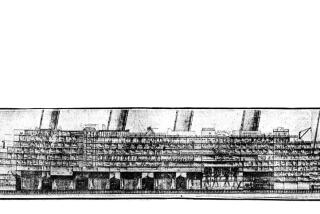Voyage of Discovery
- Share via
By the grimly conventional measure of lives lost, the sinking of the Titanic on April 15, 1912, stands well down on the list of the modern era’s major disasters. Yet the death of the great ship and 1,513 persons who sailed on it has gripped the public imagination virtually from the onset of the tragedy to this day. The earthquakes, typhoons and tidal waves that killed tens of thousands, even hundreds of thousands, before and since the Titanic disaster soon fade from popular memory. Through the generations the story of the Titanic endures.
The reason has to do with the intrinsic and carefully documented drama of the Titanic’s death. At 46,000 tons and with a length of 882 feet, it was the largest ship ever built, and its designers proclaimed it virtually unsinkable. And on its maiden voyage the Titanic sank, killing the two-thirds of those aboard for whom life boats had not been provided. Short-wave radio monitoring of the Titanic’s distress calls made the event almost immediately known. Subsequent revelations of acts of cowardice and heroism among passengers and crew added to the story’s consuming interest.
Last September, in a remarkable feat of discovery and investigation, a U.S.-French team located the wreckage of the Titanic 12,500 feet below the surface of the Atlantic, about 400 miles south of Newfoundland. In the months that followed 57,000 photographs and hours of videotape were made.A robot camera directed from the diving vessel penetrated the liner’s fractured interior, and hundreds of artifacts were observed. Most intriguing of all, surveys of the wreckage raise strong doubts about the accepted story of how the Titanic came to be mortally wounded. Robert D. Ballard, the expedition’s leader, says that he could see no evidence of the 300-foot tear that was reputedly opened below the ship’s waterline when it struck an iceberg. Instead, Ballard surmises, seams on the hull buckled when the ship brushed an iceberg.
Ballard, who says that he intends to put together a photomosaic of the Titanic wreckage, hopes that curiosity will now be satisfied and that “the Titanic can finally rest in peace.” It is a fair wish. The impressive technical effort involved in locating and photographing the wreckage brings the nearly 75-year-old story to as much of a conclusion as can be expected. Ballard and his colleagues have carried out a notable voyage of discovery. They have left what they found undisturbed--a memorial to those who died aaboard the Titanic and, in a way, a memorial to an era.
More to Read
Sign up for Essential California
The most important California stories and recommendations in your inbox every morning.
You may occasionally receive promotional content from the Los Angeles Times.













